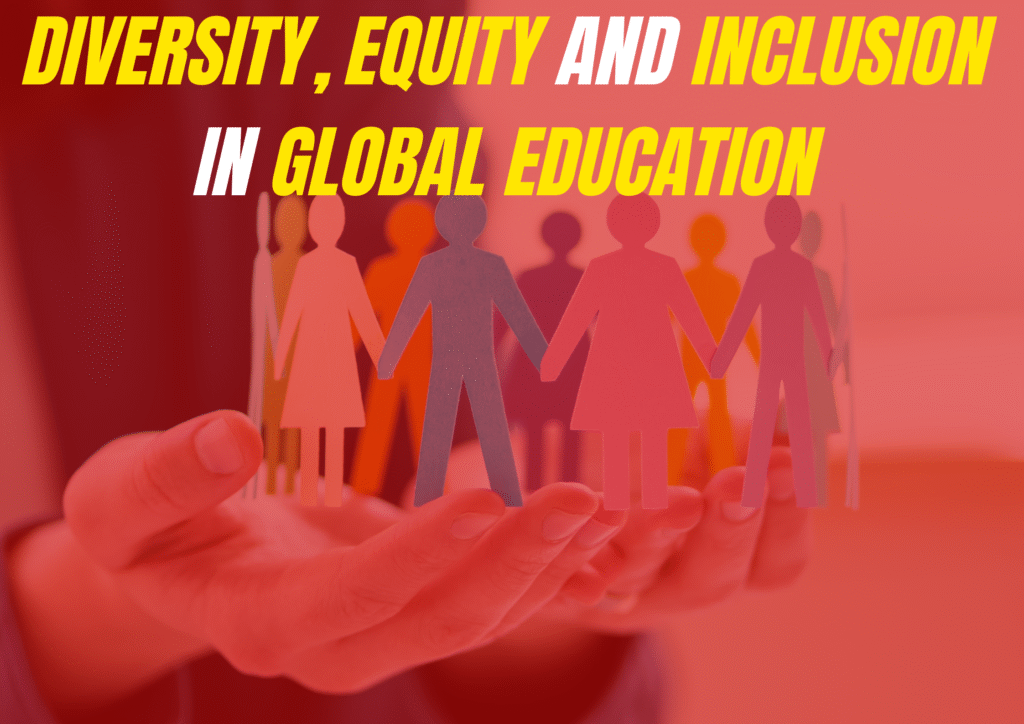Globally, education systems and institutions are increasingly embracing diversity, equity, and inclusion (DEI) as foundational pillars to prepare learners for an interconnected world. In 2025, DEI is no longer a peripheral concern but a core strategic priority that shapes policy, pedagogy, governance, and student engagement in global education.
This extensive guide examines transformative DEI strategies and trends in international education, explores challenges faced by stakeholders, spotlights inspiring initiatives, and outlines the road ahead for creating equitable and inclusive learning environments worldwide.
Table of Contents
Understanding Diversity, Equity & Inclusion in Global Education
Diversity embraces differences across cultural, ethnic, gender, socioeconomic, geographic, and ability spectrums. Equity ensures fair access to education by addressing systemic barriers and redistributing resources to historically underserved populations. Inclusion creates environments where all learners experience belonging, respect, and opportunities to thrive.
Incorporating DEI in education means developing policies and practices that not only open doors to diverse learners globally but also provide culturally responsive teaching, accessible curricula, and supportive campus climates. This holistic approach is essential for educational quality, social cohesion, and economic opportunity.
Key Drivers Behind DEI Efforts in Education in 2025
Several global trends underscore the rising importance of DEI in education:
- Demographic Shifts and Migration: Increasing cultural, linguistic, and socioeconomic diversity due to migration, refugee flows, and aging populations demands flexible, inclusive education systems.oecd
- Technological Transformation: Artificial intelligence and digital learning tools require equitable access and culturally informed design to avoid widening divides.
- Economic Inequality: Education inequities linked to income and social class remain stark; DEI policies aim to close opportunity gaps.
- Global Commitments: Goals such as UNESCO’s Education 2030 Framework and UN Sustainable Development Goal 4 emphasize inclusive, equitable quality education for all.
- Social Movements: Calls for racial justice, gender equity, LGBTQ+ rights, and disability inclusion are catalyzing reform at all education levels.unesco+1
Challenges to Implementing DEI in Global Education
Despite commitments, significant challenges persist:
- Resistance and Political Pushback: Opposition based on misconceptions, political polarization, or concerns about reverse discrimination hampers some DEI efforts.sganalytics+1
- Inconsistent Global Standards: Multinational institutions navigate varying legal, cultural, and policy environments, complicating DEI program adoption.sganalytics
- Measuring Impact: Moving beyond surface-level metrics to assess genuine inclusivity and belonging remains difficult.sganalytics
- Resource Constraints: Underfunded institutions struggle to implement comprehensive DEI interventions and support services.
- Access and Representation Gaps: Marginalized students still face barriers to enrollment, retention, and leadership opportunities.
Major DEI Initiatives and Strategies in Global Education
Localizing DEI Efforts
Successful DEI programs recognize local cultural and legal contexts. For example, universities with campuses across continents tailor initiatives to respect regional norms while upholding inclusive values, balancing global consistency with local relevance.sganalytics
Inclusive Leadership and Capacity Building
Training education leaders in cultural competency, emotional intelligence, and allyship fosters inclusive decision-making. Empowered leaders become champions of change, embedding DEI into institutional priorities.hortoninternational
Leveraging Technology for Inclusion
Educational technology supports accessibility through screen readers, multilingual platforms, and AI-powered learning aids. However, careful design is essential to avoid perpetuating biases embedded in AI algorithms.aihr+1
Student-Centered Engagement
Supporting underrepresented groups via dedicated scholarships, mentorships, and affinity groups nurtures belonging and academic success. Programs like the Global Student Programme by Universitas21 are models of inclusive access.universitas21
Data-Driven Accountability
Collecting disaggregated data on enrollment, retention, pay equity, and campus climate informs transparent goal setting and continuous improvement. Institutions increasingly adopt dashboards to track DEI progress.sganalytics
Spotlight: Global DEI Programs Impacting Education in 2025
- Global Education Diversity & Inclusion Certificate: A 9-week virtual program equipping educators and administrators with skills to lead inclusive international education efforts.daglobal
- Universitas21 Global Student Programme: Leveraging online delivery to expand access for students traditionally excluded from study abroad, with 42% of participants new to international education.universitas21
- Corporate-University Partnerships: Technology companies partner with universities to develop scholarships and mentorships that boost underrepresented students in STEM.hortoninternational
- Disability Inclusion Initiatives: Mapping and improving accessibility in global higher education through data-driven projects such as U21 Disability Inclusion Mapping.universitas21
The Economic and Social Benefits of DEI in Education
Institutions investing in DEI report enhanced:
- Student satisfaction and academic performance
- Innovation through diverse perspectives
- Graduate readiness for complex global challenges
- Community trust and reputation among stakeholders
- Socioeconomic mobility and reduced inequalityreports.weforum
Studies confirm that inclusive environments foster resilience and leadership skills crucial for success in the modern workforce.
Future Directions and Emerging DEI Trends
Equity, Diversity, Inclusion, and Belonging (EDIB)
Adding ‘Belonging’ emphasizes the emotional experience of inclusion, leading institutions to cultivate environments where all students feel recognized and valued.
Intersectionality Approaches
Programs increasingly address overlapping identities—including race, gender, disability, and socioeconomic status—to tailor support holistically. Leading institutions recognize that diversity equity inclusion requires moving beyond single-dimension solutions and embracing intersectionality as a framework. This means understanding how various factors such as ethnicity, religion, sexual orientation, migration history, and age interact to shape student experiences and outcomes.
By applying intersectional strategies, global education providers ensure that diversity equity inclusion efforts reach students with complex, layered identities. For instance, scholarships and mentorship programs may be specifically designed for women of color in STEM, LGBTQ+ students with disabilities, or refugee learners from economically disadvantaged backgrounds. Intersectionality-driven initiatives foster a deeper sense of belonging, create targeted resources for marginalized groups, and advance equity by acknowledging the unique challenges faced across multiple dimensions. This holistic lens is essential for building inclusive learning environments that empower every student.
AI and Data Analytics for Bias Mitigation
Advanced analytics assist in identifying systemic inequities, optimizing admissions, and customizing student support services.
Employee and Student-Led Initiatives
Empowering affinity groups and diversity councils to lead grassroot efforts strengthens community engagement.
Transparent and Measurable DEI Goals
Institutions set precise targets, such as gender parity in faculty or reducing gaps in retention, with public accountability.
How Students and Educators Can Support DEI
- Seek out diversity training and cultural competency workshops.
- Advocate for equitable policies and inclusive practices on campuses.
- Participate in or form student organizations promoting diversity and dialogue.
- Support peers facing barriers, fostering allyship.
- Engage critically with curricula that address systemic inequity.
Frequently Asked Questions (FAQs)
Q1: Why is diversity, equity, and inclusion critical in global education?
DEI enhances educational quality, social justice, and prepares students for global citizenship by addressing systemic barriers and fostering inclusive communities.
Q2: What barriers do underrepresented students face globally?
Barriers include financial constraints, discrimination, inadequate support, and lack of representation in faculty and leadership.
Q3: How do institutions measure DEI progress?
Through enrollment and retention data, campus climate surveys, pay equity audits, and goal tracking.
Q4: What role does technology play in DEI?
Technology enhances accessibility, provides data insights for equity, but also requires vigilance against embedded biases.
Q5: How can students contribute to DEI efforts?
By participating in training, raising awareness, joining affinity groups, and advocating inclusive policies.
Authoritative Links for Further Reading
- UNESCO – Inclusion in Education
https://www.unesco.org/en/inclusion-education - OECD Report – Equity and Inclusion in Education
https://www.oecd.org/en/publications/equity-and-inclusion-in-education_e9072e21-en.html - Universitas21 – Equity, Diversity and Inclusion
https://universitas21.com/collaborative-areas/edi/ - World Economic Forum – DEI Lighthouses 2025
https://reports.weforum.org/docs/WEF_Diversity_Equity_and_Inclusion_Lighthouses_2025.pdf - AIHR.com – Diversity, Equity, Inclusion and Belonging in the Workplace
https://www.aihr.com/blog/diversity-equity-inclusion-belonging-deib/

